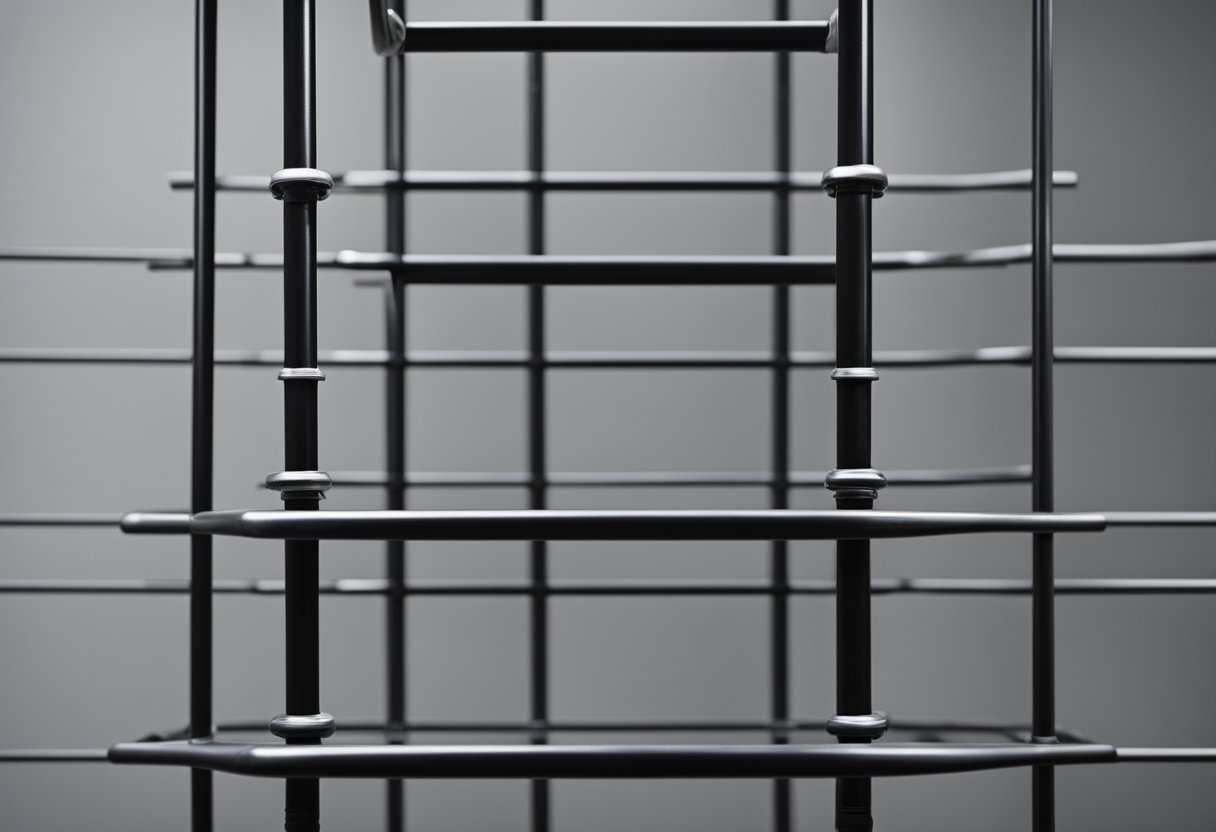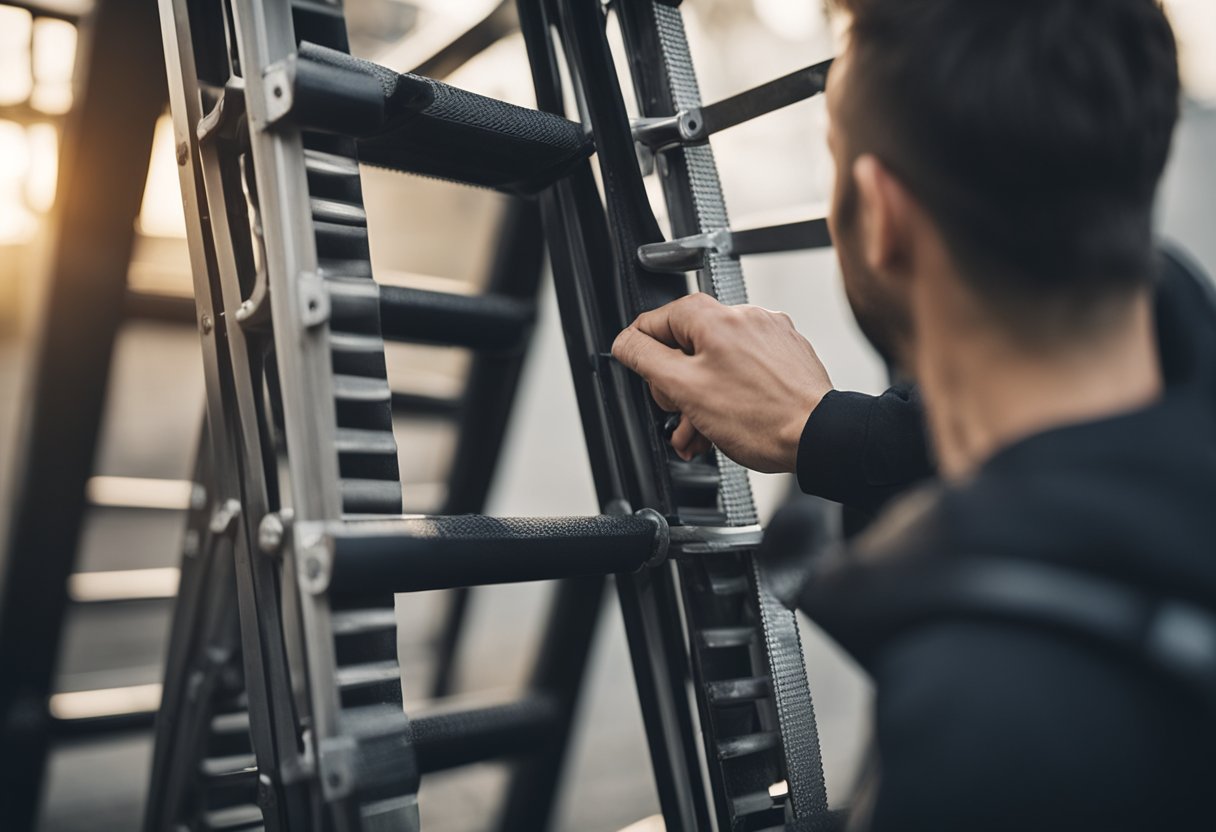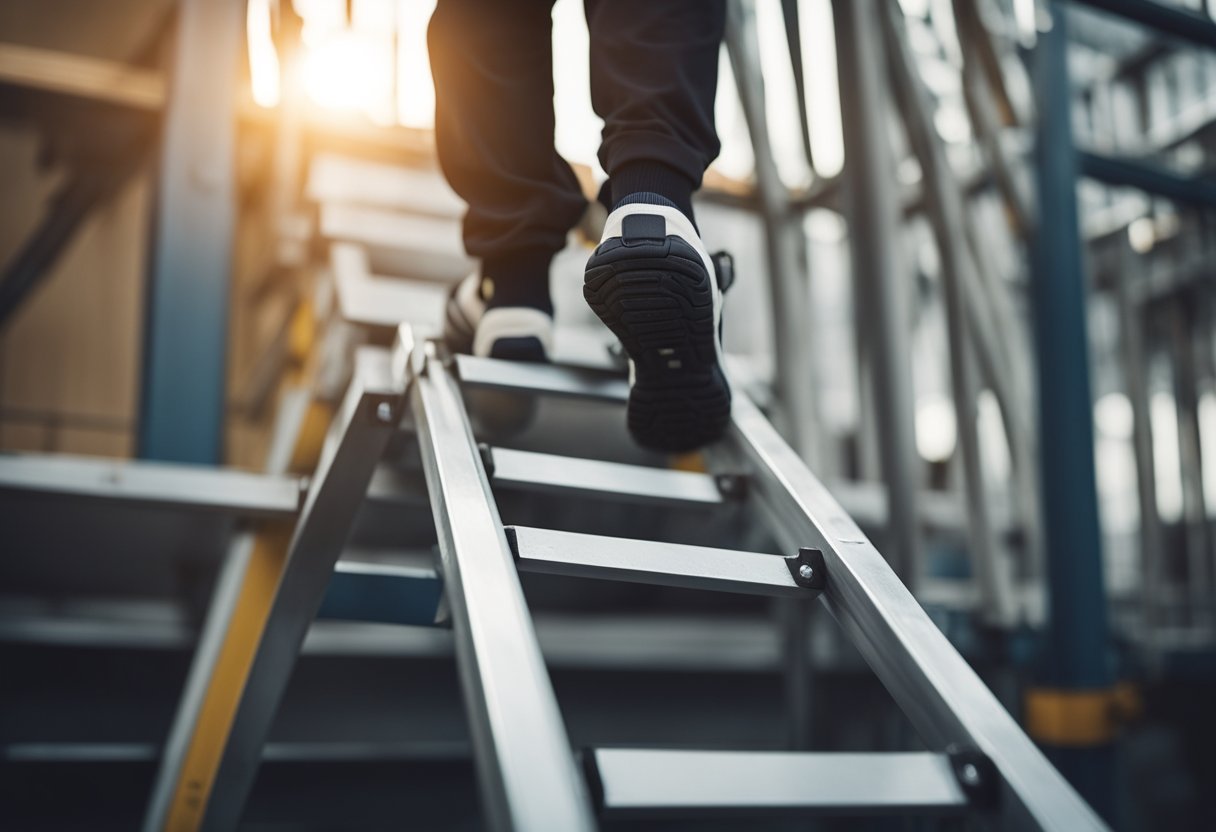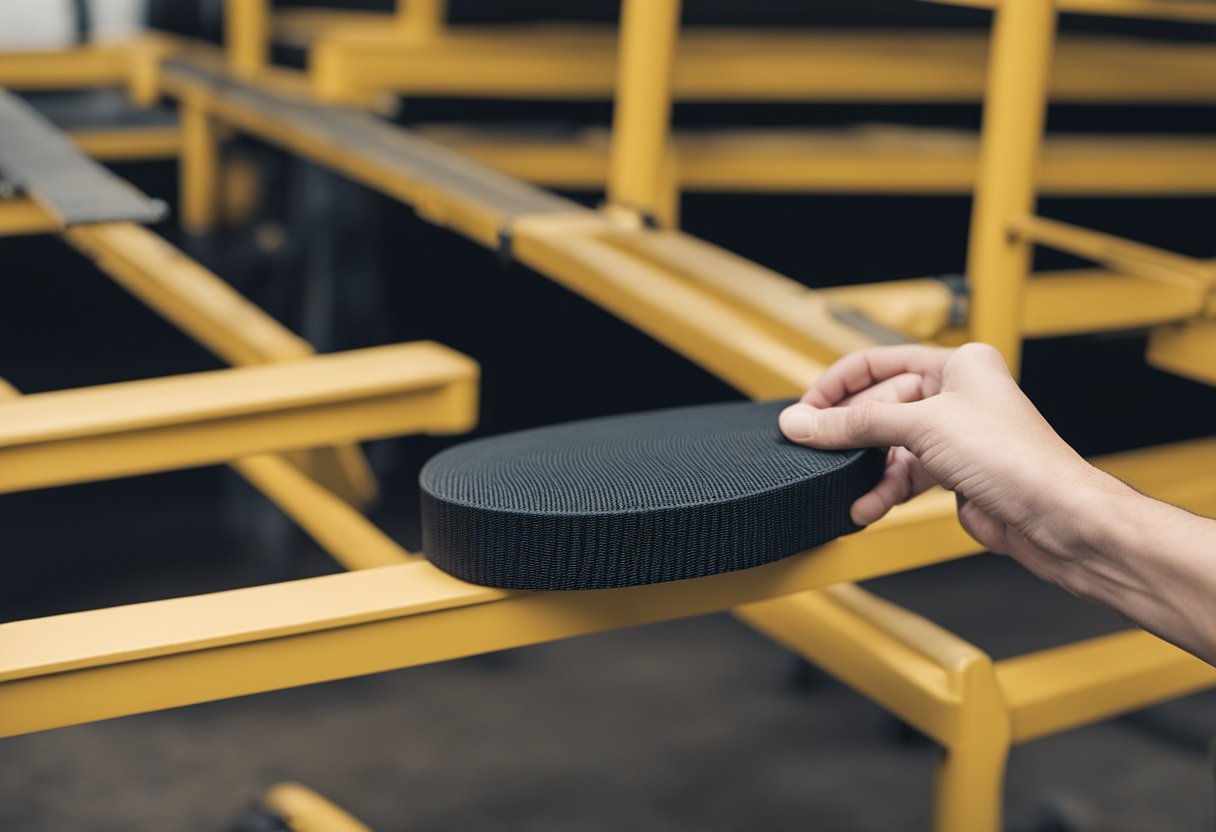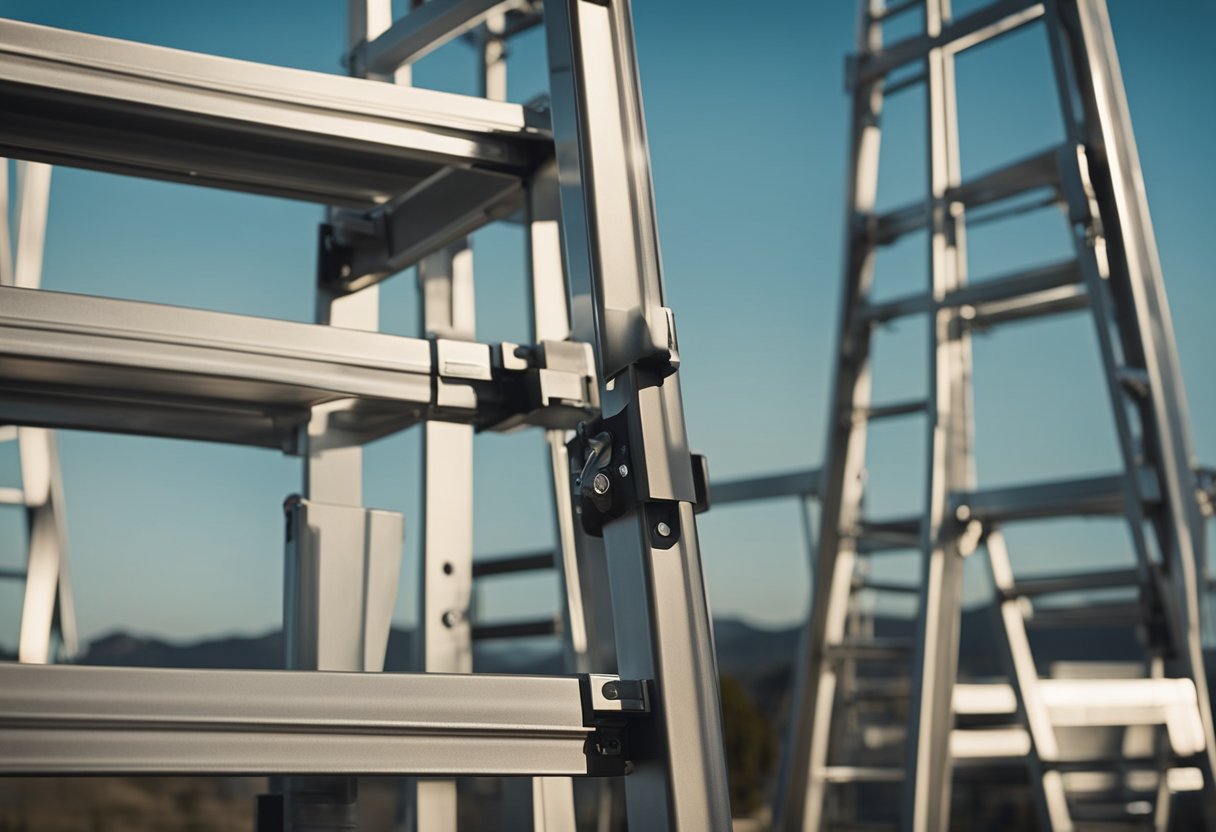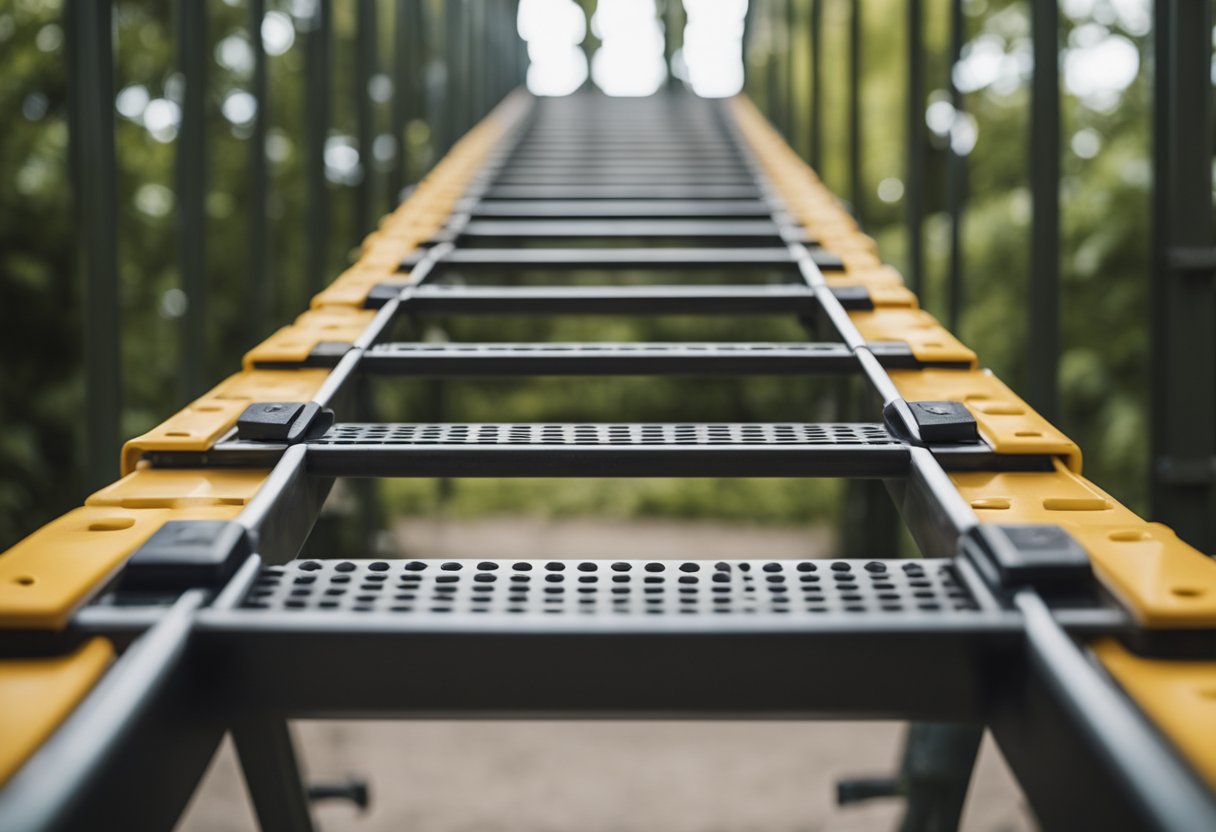Keeping a ladder from slipping is a crucial aspect of ladder safety that should never be overlooked. Whether you’re using a ladder for DIY projects, home maintenance, or professional work, it’s essential to ensure that the ladder is stable and secure. A slipping ladder can result in serious injuries, and it’s important to take the necessary precautions to prevent accidents.
To keep a ladder from slipping, several factors need to be considered. These include choosing the right ladder, utilizing ladder accessories, ensuring proper ladder placement, and dealing with different ground conditions. By taking these factors into account, you can ensure that your ladder is safe, stable, and secure, and avoid the risk of accidents or injuries. In this article, I’ll cover the essential steps you need to take to keep your ladder from slipping and ensure your safety while using ladders.
Key Takeaways
- Choose the right ladder and accessories for your needs and environment
- Ensure proper ladder placement and deal with different ground conditions
- Inspect and maintain your ladder regularly to ensure optimal safety
Understanding Ladder Safety
https://www.youtube.com/watch?v=FdLdBPURx5k&embed=true
As someone who frequently works at height, ladder safety is of paramount importance to me. It is essential to take all necessary precautions to prevent accidents and injuries while working on a ladder. Here are some key safety tips to keep in mind:
Risk Assessment
Before using a ladder, it is important to conduct a risk assessment. This involves identifying any potential hazards and taking steps to mitigate them. For example, if you are working outside, you should avoid using a ladder in high winds or storms. You should also ensure that the ladder is placed on a stable and level surface.
Work at Height Regulations 2005
In the UK, the Work at Height Regulations 2005 set out specific guidelines for working at height. These regulations require employers to take steps to prevent falls and ensure the safety of their employees. As an individual, it is also your responsibility to follow these guidelines and take all necessary precautions to protect yourself.
Ladder Safety
When using a ladder, there are several key safety tips to keep in mind. First, ensure that the ladder is positioned at an angle of 75° to prevent slipping. Second, use a ladder with rubber feet or other slip-resistant features to provide additional stability. Third, secure the ladder at the top and bottom to prevent it from moving. Fourth, use a ladder stabilizer to add additional support. Finally, use the three-point rule when climbing a ladder, which involves keeping two feet and one hand or two hands and one foot in contact with the ladder at all times.
Conclusion
By following these safety tips, you can help prevent accidents and injuries while working on a ladder. Always take the time to conduct a risk assessment, follow the Work at Height Regulations 2005, and use the ladder safely and correctly. Remember, safety should always be your top priority when working at height.
Choosing the Right Ladder
https://www.youtube.com/watch?v=Vw_qdVARfJ8&embed=true
As someone who has worked with ladders for many years, I know that choosing the right ladder is crucial to prevent slips and falls. Here are some factors to consider when choosing a ladder:
Type of Ladder
There are several types of ladders available, including extension ladders, folding ladders, and step ladders. Each type has its own advantages and disadvantages, so it’s important to choose the right one for your needs. For example, extension ladders are great for reaching high places, but they can be difficult to maneuver in tight spaces. Folding ladders are more compact and easier to store, but they may not be as stable as other types of ladders.
Ladder Height and Reach
Make sure to choose a ladder that is tall enough to reach the area you need to work on. However, don’t choose a ladder that is too tall, as this can make it unstable. It’s also important to consider the reach of the ladder, which is the distance from the ladder top to the ground. A ladder with a longer reach will be more stable than one with a shorter reach.
Ladder Feet and Hooks
The feet of the ladder are an important factor in preventing slips. Look for ladders with non-slip feet, such as rubber or plastic, to ensure that the ladder stays in place. Ladder hooks can also be helpful in securing the ladder to the surface you are working on.
Weight Capacity
Always choose a ladder with a weight capacity that is higher than your own weight, as well as the weight of any tools or materials you will be carrying. This will ensure that the ladder remains stable and secure.
By considering these factors when choosing a ladder, you can ensure that you have the right tool for the job and prevent slips and falls.
Preventing Ladder Slipping
https://www.youtube.com/watch?v=Gp63z0EQQhI&embed=true
When working with a ladder, safety should always be the top priority. One of the most common accidents that can happen when using a ladder is slipping. In this section, I will share some tips on how to prevent ladder slipping and ensure your safety.
Choose the Right Ladder
Before using a ladder, make sure it is the right size and type for the job. The ladder should be tall enough to reach the desired height, but not so tall that it becomes unstable. Additionally, the ladder should be rated for the weight it will be supporting.
Use a Level Base
A level base is essential for ladder stability. Before setting up the ladder, make sure the ground is level and firm. If the ground is uneven, use a ladder mat or other anti-slip device to level it out. A ladder mat can also help provide additional stability by gripping the ground and preventing the ladder from sliding.
Secure the Ladder
Once the ladder is set up, it is important to secure it properly. Use ladder stabilizers or other anti-slip devices to ensure the ladder is stable and secure. The Big Grip ladder stabilizer is an excellent option that can increase the footprint and grip of normal ladders from less than 4 square inches to over 480 square inches, making your ladder extremely secure.
Use Rubber Feet
Rubber feet can also help prevent ladder slipping. The rubber grips the ground and provides additional stability, preventing the ladder from sliding or shifting. Make sure the rubber feet are in good condition and replace them if they become worn or damaged.
By following these tips, you can help prevent ladder slipping and ensure your safety while using a ladder. Remember to always use caution and common sense when working with ladders, and never take unnecessary risks.
Dealing with Different Ground Conditions
https://www.youtube.com/watch?v=4QPwbY98Yec&embed=true
When working with ladders, it is important to consider the ground conditions to prevent slipping and ensure safety. Here are some tips to deal with different ground conditions:
Uneven Ground
Uneven ground can cause ladders to wobble and shift, increasing the risk of slipping. To avoid this, use ladder levelers or ladder stabilizers. Ladder levelers can be adjusted to different heights to ensure the ladder is level on uneven ground. Ladder stabilizers can be attached to the ladder and provide a wider base for added stability.
Sloping Ground
When working on sloping ground, it is important to ensure that the ladder is positioned at the correct angle. According to Ladder Geek, the recommended angle is 75 degrees. Additionally, using ladder levelers or ladder stabilizers can provide added stability on sloping ground.
Ice and Snow
Ice and snow can make the ground slippery and increase the risk of ladder slipping. It is important to clear the area where the ladder will be placed of any ice or snow. Using a ladder with ice-resistant feet or placing a non-slip mat under the ladder can also help prevent slipping.
Wet Surfaces
Wet surfaces can also increase the risk of ladder slipping. It is important to dry the area where the ladder will be placed before using the ladder. Using a ladder with non-slip feet or placing a non-slip mat under the ladder can also help prevent slipping.
Gravel
Gravel can cause the ladder to shift and wobble, increasing the risk of slipping. To prevent this, use a ladder with wide feet or place a non-slip mat under the ladder. Additionally, using ladder levelers or ladder stabilizers can provide added stability on gravel.
By considering the ground conditions and using the appropriate equipment, you can prevent ladder slipping and ensure safety when working at heights.
Utilizing Ladder Accessories
https://www.youtube.com/watch?v=s4Xl2jp5NrQ&embed=true
When it comes to ladder safety, using the right accessories can make all the difference. Here are a few ladder accessories that can help prevent slipping and improve stability:
Ladder Stabilizers
Ladder stabilizers are attachments that can be placed on the top or bottom of a ladder to increase stability and prevent wobbling or tipping. They typically consist of two side extensions that extend outward from the ladder, creating a wider and more secure base of support. Ladder stabilizers are especially useful when working on uneven surfaces or when using an extension ladder.
Ladder Mitts
Ladder mitts are rubber covers that slip over the top of the ladder rails. They provide a non-slip surface that can help prevent the ladder from sliding against the wall or other surface it is leaning against. Ladder mitts are easy to install, and can be used on most types of ladders.
Standoff Brackets
Standoff brackets are attachments that can be used to keep the ladder away from the wall or other surface it is leaning against. They provide a stable base of support and can help prevent the ladder from slipping or tipping. Standoff brackets are especially useful when working on painted or delicate surfaces.
Ladder Jacks
Ladder jacks are accessories that can be used to create a stable platform between two ladders. They are typically used when working on a roof or other elevated surface. Ladder jacks can help prevent the ladder from slipping or tipping, and can provide a stable base of support for the user.
All of these ladder accessories can be found on Amazon or at your local hardware store. By utilizing these accessories, you can improve ladder stability and prevent slipping, which can help keep you safe while working at heights.
Inspecting and Maintaining Your Ladder
As someone who frequently uses ladders, I know that inspecting and maintaining your ladder is crucial to prevent accidents and ensure safety. Here are some tips for keeping your ladder in good condition:
1. Inspect your ladder before each use
Before climbing your ladder, it’s important to inspect it for any damage or defects. Check the rungs, rails, and feet for cracks, bends, or other signs of wear and tear. If you notice any damage, do not use the ladder and replace it immediately.
2. Clean your ladder regularly
Dirt, debris, and other materials can accumulate on your ladder, making it slippery and unsafe to use. To prevent slips and falls, clean your ladder regularly with a damp cloth or sponge. Avoid using harsh chemicals or abrasive materials that could damage the ladder.
3. Store your ladder properly
When not in use, store your ladder in a dry, cool place away from direct sunlight. Avoid storing it in a damp or humid area, as this can cause rust and corrosion. If possible, store your ladder in a protective case or cover to prevent damage.
4. Use a ladder stabilizer
A ladder stabilizer can help prevent slips and falls by providing additional support and stability to your ladder. These devices attach to the top of your ladder and extend outwards, creating a wider base and reducing the risk of tipping.
By following these tips, you can help prevent ladder accidents and ensure your safety when using a ladder. Remember to always follow ladder safety information and take the necessary precautions to protect yourself from slips and falls.
Avoiding Hazards While Using Ladders
As someone who has used ladders for various tasks, I know how important it is to be aware of potential hazards. Here are some tips to avoid hazards while using ladders:
1. Check for Power Lines
Before setting up your ladder, make sure to check for power lines. It is essential to keep a safe distance from any power lines to avoid electrocution. If you need to work near power lines, use a fiberglass ladder as it is non-conductive.
2. Mind the Gutters and Overhangs
Be aware of gutters and overhangs when placing your ladder. A ladder that is not placed correctly can cause damage to gutters or overhangs and lead to injury. To avoid this, make sure the ladder is placed on a stable surface, and the feet are level. You can use ladder stabilizers to add additional support and prevent the ladder from slipping.
3. Use Scaffolding
When working on a project that requires a ladder, consider using scaffolding instead. Scaffolding is a safer option as it provides a stable platform and eliminates the need for a ladder. Scaffolding is also adjustable, making it easier to work at different heights.
4. Wear Proper Footwear
Wearing proper footwear is essential when using a ladder. Shoes with non-slip soles provide better traction, reducing the risk of slipping or falling. Avoid wearing sandals or flip-flops, as they do not provide adequate support or stability.
By following these tips, you can avoid hazards while using ladders. Remember to always prioritize safety and take the necessary precautions to prevent accidents.
Ensuring Proper Ladder Placement
When using a ladder, it is crucial to ensure that it is placed on a stable and level surface. A ladder that is not level can easily tip over and cause serious injury. Here are some tips to ensure proper ladder placement:
-
Use a leveler: A leveler is a device that can be attached to the bottom of the ladder to ensure that it is level. This is especially useful when working on uneven surfaces.
-
Adjust the ladder feet: Most ladders have adjustable feet that can be used to level the ladder. Make sure to adjust the feet so that they are flat on the ground and not sinking into soft soil.
-
Avoid using wooden surfaces: Wooden surfaces can be slippery, especially when wet. It is best to avoid using a ladder on a wooden surface if possible.
-
Check for sinking: If the ladder is sinking into the ground, it is not level and should not be used. Make sure to place the ladder on a solid surface.
By following these tips, you can ensure that your ladder is properly placed and reduce the risk of slipping or tipping over. Always take the time to check your ladder placement before climbing up to ensure your safety.
Cost-Effective Ladder Safety Solutions
As a DIY enthusiast or a professional contractor, you want to ensure that you’re using your ladder safely. Slipping and falling from a ladder can cause serious injuries, and it’s essential to take the necessary precautions to prevent accidents. Here are some cost-effective ladder safety solutions that you can use to keep your ladder from slipping:
Rubber Mats
Rubber mats are a great way to prevent your ladder from slipping, especially if you’re working on a smooth or slippery surface. You can place the rubber mats under the ladder’s feet to create a stable base. Rubber mats are affordable and easy to find, and they’re an excellent investment for anyone who uses a ladder frequently.
Ladder Stabilizers
Ladder stabilizers are an excellent investment if you want to ensure that your ladder is stable and secure. A ladder stabilizer attaches to the top of your ladder and provides extra support and stability. It’s an affordable and easy-to-use solution that can prevent your ladder from slipping or wobbling while you’re working.
Anti-Slip Tape
Anti-slip tape is an affordable and effective way to prevent your ladder from slipping. You can apply the tape to the ladder’s feet, and it will create a non-slip surface that will prevent the ladder from sliding. Anti-slip tape is easy to find and install, and it’s an excellent solution for anyone who wants to ensure ladder safety without spending a lot of money.
Proper Placement
One of the simplest and most cost-effective ways to prevent your ladder from slipping is to ensure that it’s placed on a stable and level surface. Before you climb the ladder, make sure that it’s on a flat and even surface. If the surface is uneven, you can use shims or blocks to level the ladder. Proper placement is essential for ladder safety, and it’s a solution that won’t cost you anything.
In conclusion, ladder safety is essential, and there are many cost-effective solutions that you can use to prevent your ladder from slipping. Whether you choose rubber mats, ladder stabilizers, anti-slip tape, or proper placement, it’s essential to take the necessary precautions to ensure your safety while using a ladder.
Frequently Asked Questions
What are some accessories that can help secure a ladder?
There are several accessories that can help secure a ladder, such as ladder stabilizers, anti-slip devices, and ladder mats. Ladder stabilizers are designed to prevent the ladder from tipping over, while anti-slip devices add extra grip to the ladder feet. Ladder mats are also useful for providing additional traction on slippery surfaces.
How can you prevent a ladder from slipping on hardwood floors?
One way to prevent a ladder from slipping on hardwood floors is to use a ladder mat. Ladder mats are designed to provide extra traction on smooth surfaces. Additionally, you can also use an anti-slip device on the ladder feet to prevent slipping.
What is the best way to keep a ladder in place?
The best way to keep a ladder in place is to ensure that it is on a stable and level surface. You can also use a ladder stabilizer to add additional support and prevent the ladder from tipping over. Additionally, you can use the three-point rule when climbing a ladder to ensure that it stays in place.
What are some techniques for holding a ladder for someone?
When holding a ladder for someone, it is important to stand on a stable surface and keep both hands on the ladder at all times. You should also avoid leaning the ladder against a wall or other surface, as this can cause it to slip. Instead, hold the ladder at the base and use your body weight to keep it in place.
Should you tie a ladder at the top or bottom?
It is generally recommended to tie a ladder at the top, as this provides additional stability and prevents the ladder from slipping. However, you can also tie the ladder at the bottom if necessary. Just be sure to use a secure knot and ensure that the ladder is on a stable surface.
What are some common causes of ladder slips?
Some common causes of ladder slips include using a ladder on an uneven or unstable surface, not setting up the ladder at the correct angle, using a ladder that is too short for the job, and overreaching while on the ladder. It is important to follow ladder safety guidelines to prevent slips and falls.

Hi, I’m Sal Muller of Tooltrip.com. My DIY experience led me to understand essential power tools for home projects. Tooltrip.com guides enthusiasts and professionals in choosing right tools for any job. I provide concise top tool reviews for easier, efficient DIY.

